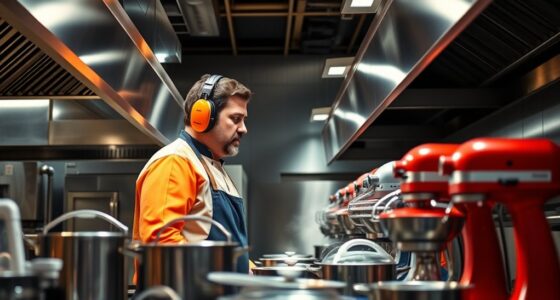To implement effective IPM in your restaurant, regularly monitor for pests with traps and visual checks, and act early on signs of activity. Keep your premises clean by removing food residues, storing waste properly, and eliminating clutter. Use physical barriers like door sweeps and screens to prevent pest entry. Manage outdoor surroundings to reduce entry points and support sanitation efforts. Training your staff ensures everyone plays a role in pest prevention. Continuing with these practices will help you maintain a pest-free environment.
Key Takeaways
- Regular pest monitoring through inspections and traps enables early detection and targeted control efforts.
- Maintaining strict sanitation by cleaning surfaces, floors, and proper waste storage reduces pest attractants.
- Managing outdoor environments and sealing entry points prevent pests from entering the restaurant.
- Installing physical barriers like door sweeps and screens blocks pest entry and enhances exclusion.
- Training staff to recognize signs of pests and follow sanitation protocols promotes a collaborative IPM approach.

Are pests causing problems in your restaurant? If so, it’s time to take proactive steps through an effective Integrated Pest Management (IPM) plan. IPM isn’t just about pest control; it’s about prevention, monitoring, and maintaining a clean environment that discourages pests from taking hold. The foundation of a successful IPM approach starts with consistent pest monitoring. Regular inspections allow you to identify pest activity early before it becomes a full-blown infestation. By setting up traps and conducting visual checks, you can gather vital data on pest types, entry points, and activity patterns. This information helps you target your control efforts precisely, reducing the need for chemical solutions and minimizing disruptions to your operations.
Equally important is practicing good sanitation. Pests are attracted to food residues, spills, and clutter, so maintaining strict sanitation practices is essential. Clean all surfaces thoroughly, especially in food prep areas, storage rooms, and trash disposal zones. Make sure that floors are swept and mopped regularly, and that food waste is promptly removed and properly stored in sealed containers. Eliminating pest attractants reduces the chances of pests settling in your establishment. Remember, even small crumbs or leaks can serve as a welcome mat for rodents, cockroaches, or flies. Additionally, understanding the importance of outdoor environment management can further reduce pest entry points by preventing pests from approaching your building in the first place. By integrating sanitation practices into your daily routine, you create a hostile environment for pests and make your restaurant less appealing to them.
In addition to monitoring and sanitation, implementing physical barriers like door sweeps, sealing cracks, and installing screens can considerably reduce pest entry points. It’s also essential to train your staff in recognizing early signs of pest activity and in maintaining high sanitation standards. This teamwork guarantees that pest management becomes a shared responsibility, rather than a one-time fix. When combined, pest monitoring and sanitation practices form the backbone of an effective IPM strategy, helping you keep pests at bay while maintaining food safety and compliance with health standards.
Frequently Asked Questions
How Often Should IPM Inspections Be Conducted in Restaurants?
You should conduct IPM inspections in your restaurant at least monthly to make certain of effective pest monitoring. Regular inspection frequency helps catch issues early and prevents infestations. Keep in mind that high-risk areas like kitchens and storage rooms may require more frequent checks, such as bi-weekly. Consistent pest monitoring and timely inspections are key to maintaining a pest-free environment and complying with health standards.
Are There Specific IPM Products Safe for Food Contact Surfaces?
Yes, there are food-safe products designed specifically for surface contact in restaurants. You should look for pest control solutions labeled as safe for use around food and that meet regulatory standards. Always follow manufacturer instructions to guarantee they’re applied properly and allow sufficient drying time before resuming food contact activities. Using these food-safe products helps you effectively manage pests while maintaining a safe, hygienic environment for your staff and customers.
Can IPM Methods Eliminate All Pest Issues Completely?
Think of pest prevention like trying to keep a flood at bay; IPM methods can’t wipe out all pests completely. While they considerably reduce infestations, some pests might still slip through cracks. By using chemical alternatives wisely and maintaining good sanitation, you create a fortress against pests. Remember, IPM is a proactive approach, but it’s not a magic wand—constant vigilance is key to minimizing pest issues in your restaurant.
What Training Is Required for Restaurant Staff on IPM Practices?
You need to guarantee your restaurant staff receives proper training on IPM practices through staff certification programs. This training covers pest identification, prevention, and proper response techniques. It’s important to provide ongoing education to keep everyone updated on the latest methods and regulations. By doing so, you empower your team to effectively implement IPM strategies, helping to minimize pests and maintain a safe, clean environment for your customers and staff.
How to Handle Pest Infestations During Busy Restaurant Hours?
During busy hours, act quickly to handle pest infestations by calmly isolating the affected area and notifying your pest management team immediately. Focus on quick response to prevent pests from spreading and causing further damage. Keep your staff vigilant about pest prevention, such as maintaining cleanliness and promptly addressing any signs of pests. Your proactive approach minimizes disruption, ensuring a safe and pest-free environment for both staff and customers.
Conclusion
By embracing effective, eco-friendly, and easy-to-implement IPM practices, you protect your restaurant’s reputation and reputation. Staying vigilant, vigilant, and vigilant again guarantees pests are kept at bay, boosting your business’s success. Remember, proactive prevention prevents pest problems, providing a pristine, pest-free environment. With wise, consistent management, you’ll win the war against unwelcome pests, ensuring diners delight in your clean, cared-for establishment every time. Protect, prevent, and prevail with powerful IPM principles.








